Concept Development and Field Testing of Wireless Outdoor Indicator System for Use in Monitoring Exposures at Work among Malaysian Traffic Police
Abstract
1. Introduction
2. Materials and Methods
2.1. The System
2.2. Importance for Traffic Police
2.3. The Conceptual Design
2.4. Experiment Location
2.5. Data Analysis
3. Results
3.1. Conceptual Design Based on PDS
3.2. Measurement Results
3.3. Correlation between the Prototype and the Reference Instrument for PM2.5, NO2, and CO
3.4. Linear Regression Test for Calibration
4. Conclusions
Author Contributions
Funding
Institutional Review Board Statement
Informed Consent Statement
Data Availability Statement
Acknowledgments
Conflicts of Interest
References
- Ahmad, R.H. We’re unaware that air pollution is a silent killer. New Straits Times, 29 August 2019; 1. [Google Scholar]
- World Health Organization. How Air Pollution Is Destroying Our Health; World Health Organization: Geneva, Switzerland, 2018. [Google Scholar]
- Fattore, E.; Paiano, V. Health risk in relation to air quality. Res. Pract. 2008, 24, 6. [Google Scholar]
- Jamil, P.A.S.M. Risk Factors of Respiratory Effects from Works Exposure and PM2.5 among Traffic Policemen. Master’s Thesis, Universiti Putra Malaysia, Selangor, Malaysia, 2017. [Google Scholar]
- Sulaiman, N.S.; Zurahanim, F.A. DNA changes in lymphocytes among Malaysian traffic police officers exposed to air pollutants. J. Occup. Saf. Health 2014, 11, 77. [Google Scholar]
- El Raey, M. Air Quality and Atmospheric Pollution in the Arab Region; Regional Office for West Asia Report; ESCWA: Beirut, Lebanon; League of Arab States: Cairo, Egypt, 2006. [Google Scholar]
- Purwanto, P.; Suryono, S.; Sunarno, S. Design of air quality monitoring system based on web using wireless sensor network. J. Phys. Conf. Ser. 2019, 1295, 012043. [Google Scholar] [CrossRef]
- Kim, S.; Paulos, E.; Mark, D.G. WearAir: Expressive t-shirts for air quality sensing. In Proceedings of the Fourth International Conference on Tangible, Embedded, and Embodied Interaction, Cambridge, MA, USA, 24–27 January 2010; pp. 295–296. [Google Scholar]
- Yi, W.Y.; Lo, K.M.; Mak, T.; Leung, K.S.; Leung, Y.; Meng, M.L. A survey of wireless sensor network based air pollution monitoring systems. Sensors 2015, 15, 31392–31427. [Google Scholar] [CrossRef] [PubMed]
- Maraiya, K.; Kant, K.; Gupta, N. Application based study on wireless sensor network. Int. J. Comput. Appl. 2011, 21, 9–15. [Google Scholar] [CrossRef]
- Kaivonen, S.; Ngai, E.C. Real-time air pollution monitoring with sensors on city bus. Digit. Commun. Netw. 2020, 6, 23–30. [Google Scholar] [CrossRef]
- Morawska, L.; Thai, P.K.; Liu, X.; Asumadu-Sakyi, A.; Ayoko, G.; Bartonova, A.; Bedini, A.; Chai, F.; Christensen, B.; Dunbabin, M.; et al. Applications of low-cost sensing technologies for air quality monitoring and exposure assessment: How far have they gone? Environ. Int. 2018, 116, 286–299. [Google Scholar] [CrossRef]
- Castell, N.; Dauge, F.R.; Schneider, P.; Vogt, M.; Lerner, U.; Fishbain, B.; Broday, D.; Bartonova, A. Can commercial low-cost sensor platforms contribute to air quality monitoring and exposure estimates? Environ. Int. 2017, 99, 293–302. [Google Scholar] [CrossRef]
- Jamil, P.A.; Karuppiah, K.; Rasdi, I.; How, V.; Tamrin, S.B.; Mani, K.K.; Sambasivam, S.; Yusof, N.A.; Hashim, N.M. Associations of Occupational, Socio-Demographic and Lifestyle Factors with Lung Functions in Malaysian Traffic Policemen. Ann. Glob. Health 2020, 86, 84. [Google Scholar] [CrossRef]
- Jamil, P.A.; Yusof, N.A.; Karuppiah, K.; Rasdi, I.; Jalalludin, J.; Tamrin, S.B.; How, V.; Sambasivam, S.; Hashim, N.M. Malaysian Traffic Police in Highly Populated Areas: Is it Safe Working Outdoors on a Daily Basis? Aerosol Air Qual. Res. 2020, 20, 2003–2011. [Google Scholar] [CrossRef]
- Instruction Guide and Macro Analysis Tool: Evaluating Low-Cost Air Sensors by Collocation with Federal Reference Monitors. Available online: https://www.epa.gov/air-research/instruction-guide-and-macro-analysis-tool-evaluating-low-cost-air-sensors-collocation (accessed on 2 January 2020).
- Michel, G.; Laurent, S.; Annette, B. Measuring Air Pollution with Low-Cost Sensors; European Commission: Brussels, Belgium, 2017. [Google Scholar]
- Emily, S.; Paul, S.; Ronald, W.; Eben, T.; Dena, V. Low Cost Sensors-Current Capabilities and Gaps. ISEE Conf. Abstr. 2013, 2013, 5840. [Google Scholar]
- McKercher, G.R.; Vanos, J.K. Low-cost mobile air pollution monitoring in urban environments: A pilot study in Lubbock, Texas. Environ. Technol. 2018, 39, 1505–1514. [Google Scholar] [CrossRef]
- Johnson, K.K.; Bergin, M.H.; Russell, A.G.; Hagler, G.S. Using low cost sensors to measure ambient particulate matter concentrations and on-road emissions factors. Atmos. Meas. Tech. Discuss. 2016. preprints. [Google Scholar] [CrossRef]
- Fezari, M.; Boumaza, M.S.; Al-Dahoud, A.; Al-Dahoud, A. WSN for AIR Quality Monitoring in Annaba City. In Proceedings of the 7th International Conference on Information Technology ICIT, Amman, Jordan, 12–15 May 2015; pp. 283–288. [Google Scholar]
- Tomić, J.; Kušljević, M.; Vidaković, M.; Rajs, V. Smart SCADA system for urban air pollution monitoring. Measurement 2014, 58, 138–146. [Google Scholar] [CrossRef]
- Jamil, P.A.; Karuppiah, K.; Rasdi, I.; How, V.; Tamrin, S.B.; Mani, K.K.; Sambasivam, S.; Naeini, H.S.; Yusof, N.A.; Hashim, N.M. Occupational hazard in Malaysian traffic police: Special focus on air pollutants. Rev. Environ. Health 2021, 6, 167–176. [Google Scholar] [CrossRef]
- Othman, M.F.; Shazali, K. Wireless sensor network applications: A study in environment monitoring system. Procedia Eng. 2012, 41, 1204–1210. [Google Scholar] [CrossRef]
- Jamil, P.A.; Yusof, N.A.; Karuppiah, K.; Rasdi, I.; How, V.; Tamrin, S.B.; Mani, K.K.; Naeni, H.S.; Sambasivam, S.; Nata, D.H. The Impacts of Urban Air Pollution on Malaysian Traffic Police: A Framework for Evaluation of Real-Time Monitoring System on Its Usability. IOP Conf. Ser. Earth Environ. Sci. 2022, 1013, 012003. [Google Scholar] [CrossRef]
- Meiryani, S.A. System development method with the prototype method. Int. J. Sci. Technol. Res. 2019, 8, 141–144. [Google Scholar]
- Environment Agency. Monitoring Ambient Air; Version 2; Environment Agency: Bristol, UK, 2011. [Google Scholar]
- Department of Environment. Air Quality Air Quality in the Country Is Monitored Continuously…. Available online: https://www.doe.gov.my›portalv1›uploads›2013/01 (accessed on 2 January 2022).
- United Stated Environmental Protection Agency. Ambient Air Quality Source Measurement and Emissions Factors Research. Available online: https://www.epa.gov/air-research/ambient-air-quality-sourcemeasurementandemissions-factors-research (accessed on 2 January 2022).
- New Zealand Government. Report of the Ministry for the Environment for the Year Ended 30 June 2010. Available online: https://environment.govt.nz/publications/report-of-the-ministry-for-the-environment-for-the-year-ended-30-june-2010/overview-of-the-200910-year/ (accessed on 2 January 2022).
- Liu, J.H.; Chen, Y.F.; Lin, T.S.; Lai, D.W.; Wen, T.H.; Sun, C.H.; Juang, J.Y.; Jiang, J.A. Developed urban air quality monitoring system based on wireless sensor networks. In Proceedings of the 2011 Fifth International Conference on Sensing Technology, Palmerston North, New Zealand, 28 November–1 December 2011; pp. 549–554. [Google Scholar]
- DustTrak™ II Aerosol Monitor 8530. TSI Incorporated. Available online: https://tsi.com/products/aerosol-and-dust-monitors/aerosol-and-dust-monitors/dusttrak%E2%84%A2-ii-aerosol-monitor-8530/ (accessed on 2 January 2022).
- Sapuan, S.M.; Maleque, M.A.; Hameedullah, M.; Suddin, M.N.; Ismail, N. A note on the conceptual design of polymeric composite automotive bumper system. J. Mater. Process. Technol. 2005, 159, 145–151. [Google Scholar] [CrossRef]
- Can, Z.; Demirbas, M. Smartphone-based data collection from wireless sensor networks in an urban environment. J. Netw. Comput. Appl. 2015, 58, 208–216. [Google Scholar] [CrossRef]
- Bhatt, A.; Sharma, M.P.; Saini, R.P. Feasibility and sensitivity analysis of an off-grid micro hydro–photovoltaic–biomass and biogas–diesel–battery hybrid energy system for a remote area in Uttarakhand state, India. Renew. Sustain. Energy Rev. 2016, 61, 53–69. [Google Scholar] [CrossRef]
- Murad, M.A.A.; Tzounas, G.; Liu, M.; Milano, F. Frequency control through voltage regulation of power system using SVC devices. In Proceedings of the 2019 IEEE Power & Energy Society General Meeting (PESGM), IEEE, Atlanta, GA, USA, 4–8 August 2019; pp. 1–5. [Google Scholar]
- Liu, Y.; Lin, Y.; Ren, G.; Zhou, D. Analysis on the classification and research direction of wireless charging technology. J. Phys. Conf. Ser. 2021, 1972, 012008. [Google Scholar] [CrossRef]
- Pritchard, H.; Gabrys, J.; Houston, L. Re-calibrating DIY: Testing digital participation across dust sensors, fry pans and environmental pollution. New Media Soc. 2018, 20, 4533–4552. [Google Scholar] [CrossRef]
- Tianlong, N. Application of single bus sensor DHT11 in temperature humidity measure and control system. Microcontrollers Embed. Syst. 2010, 6, 26. [Google Scholar]
- Singh, P.; Saikia, S. Arduino-based smart irrigation using water flow sensor, soil moisture sensor, temperature sensor and ESP8266 WiFi module. In Proceedings of the 2016 IEEE Region 10 Humanitarian Technology Conference (R10-HTC), IEEE, Agra, India, 21–23 December 2016; pp. 1–4. [Google Scholar]
- Verma, N.; Shoeb, A.; Bohorquez, J.; Dawson, J.; Guttag, J.; Chandrakasan, A.P. A micro-power EEG acquisition SoC with integrated feature extraction processor for a chronic seizure detection system. IEEE J. Solid-State Circuits 2010, 45, 804–816. [Google Scholar] [CrossRef]
- Zhang, S.; Yang, M.; Liang, K.; Turak, A.; Zhang, B.; Meng, D.; Wang, C.; Qu, F.; Cheng, W.; Yang, M. An acetone gas sensor based on nanosized Pt-loaded Fe2O3 nanocubes. Sens. Actuators B Chem. 2019, 290, 59–67. [Google Scholar] [CrossRef]
- Austin, E.; Novosselov, I.; Seto, E.; Yost, M.G. Laboratory evaluation of the Shinyei PPD42NS low-cost particulate matter sensor. PLoS ONE 2015, 10, e0137789. [Google Scholar]
- Department of Environment Malaysia. New Ambient Air Quality Standard. Available online: https://www.doe.gov.my/portalv1/wp-content/uploads/2013/01/Air-Quality-Standard-BI.pdf (accessed on 2 January 2022).
- Borrego, C.; Amorim, J.H.; Tchepel, O.; Dias, D.; Rafael, S.; Sá, E.; Pimentel, C.; Fontes, T.; Fernandes, P.; Pereira, S.R.; et al. Urban scale air quality modelling using detailed traffic emissions estimates. Atmos. Environ. 2016, 131, 341–351. [Google Scholar] [CrossRef]
- Gonzalez, A.; Boies, A.; Swason, J.; Kittelson, D. Field calibration of low-cost air pollution sensors. Atmos. Meas. Tech. Discuss. 2019. preprint. [Google Scholar]
- Genikomsakis, K.N.; Galatoulas, N.F.; Dallas, P.I.; Candanedo Ibarra, L.M.; Margaritis, D.S.; Ioakimidis, C. Development and on-field testing of low-cost portable system for monitoring PM2.5 concentrations. Sensors 2018, 18, 1056. [Google Scholar] [CrossRef]
- Zheng, T.; Bergin, M.H.; Johnson, K.K.; Tripathi, S.N.; Shirodkar, S.; Landis, M.S.; Sutaria, R.; Carlson, D.E. Field evaluation of low-cost particulate matter sensors in high-and low-concentration environments. Atmos. Meas. Tech. 2018, 11, 4823–4846. [Google Scholar] [CrossRef]
- Wahid, H. Design of a measurement device for air pollution concentrations using an open-source electronics software and hardware system. Int. J. Integr. Eng. 2017, 9, 61–70. [Google Scholar]
- Husain, A.M.; Rini, T.H.; Haque, M.I.; Alam, M.R. Air quality monitoring: The use of arduino and android. J. Mod. Sci. Technol. 2016, 4, 86–96. [Google Scholar]
- Jiang, B.; Huacón, C.F. Cloud-based smart device for environment monitoring. In Proceedings of the 2017 IEEE Conference on Technologies for Sustainability (SusTech), IEEE, Phoenix, AZ, USA, 12–14 November 2017; pp. 1–6. [Google Scholar]
- Ju, J.D.; Kim, J.S.; Kang, B.G.; Shim, J. Implementation of Mobile Multi-sensor System for Measuring an Environment. J. Korea Multimed. Soc. 2014, 17, 1020–1024. [Google Scholar] [CrossRef]
- Karagulian, F.; Barbiere, M.; Kotsev, A.; Spinelle, L.; Gerboles, M.; Lagler, F.; Redon, N.; Crunaire, S.; Borowiak, A. Review of the performance of low-cost sensors for air quality monitoring. Atmosphere 2019, 10, 506. [Google Scholar] [CrossRef]

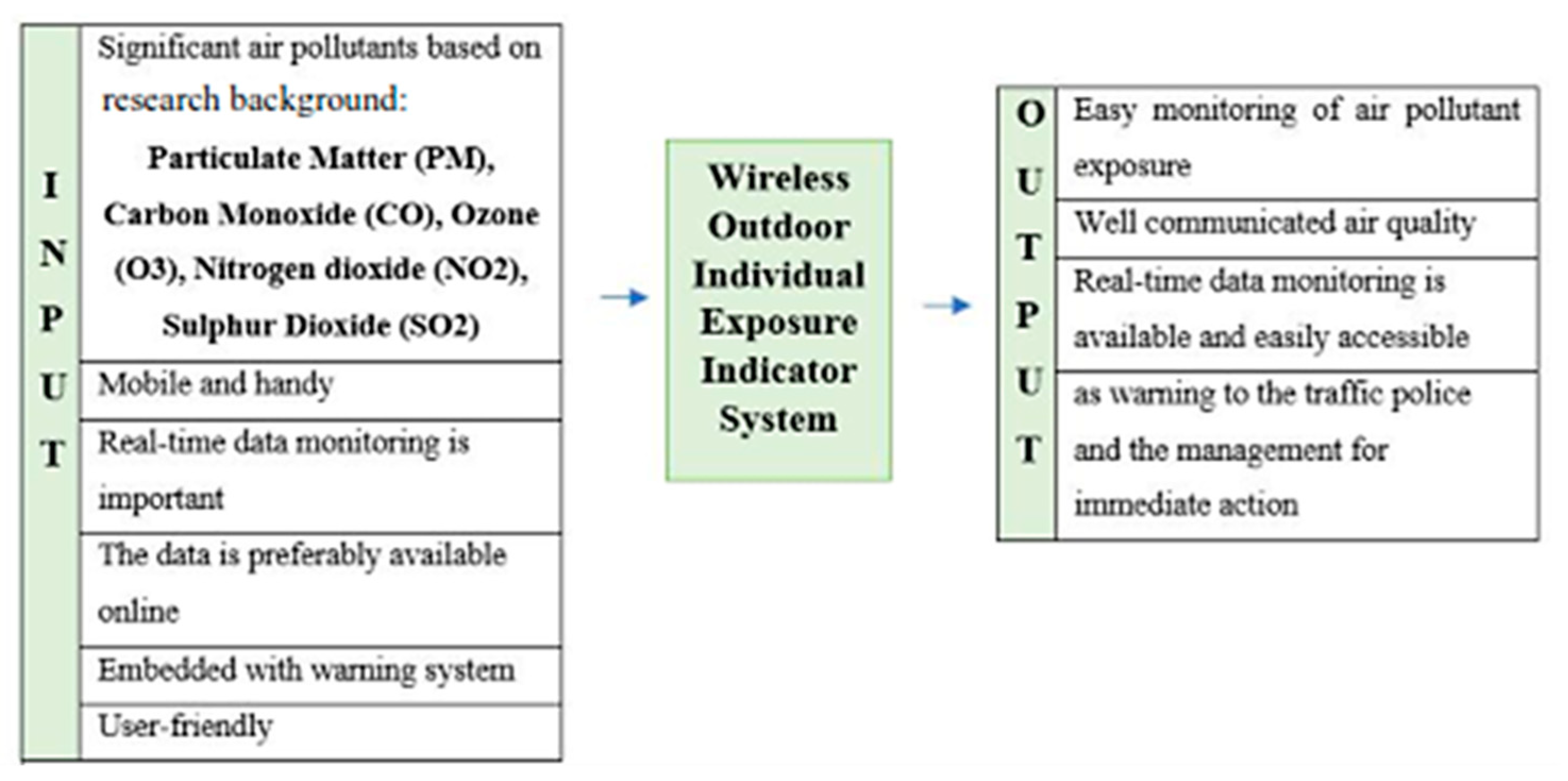
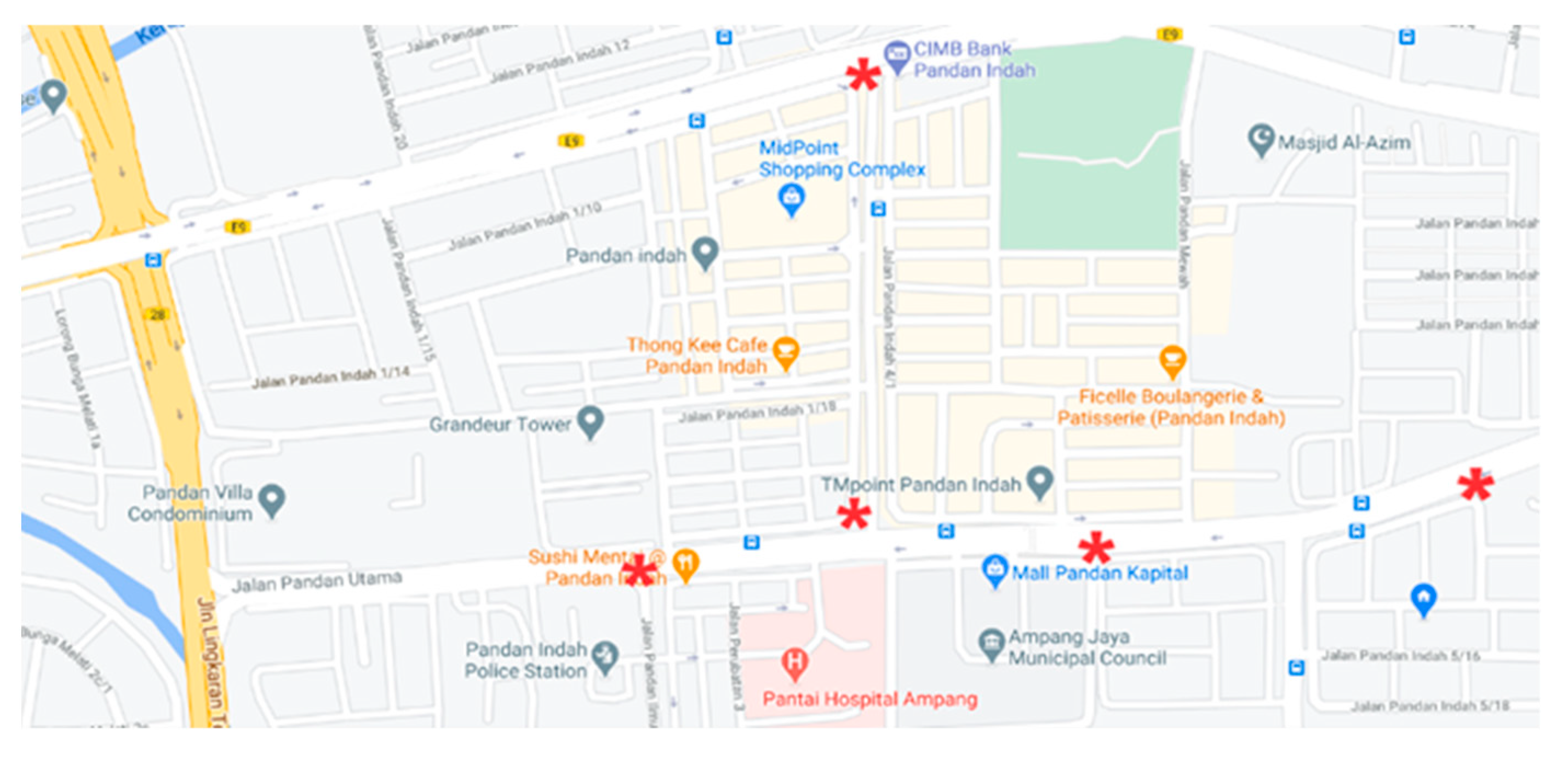
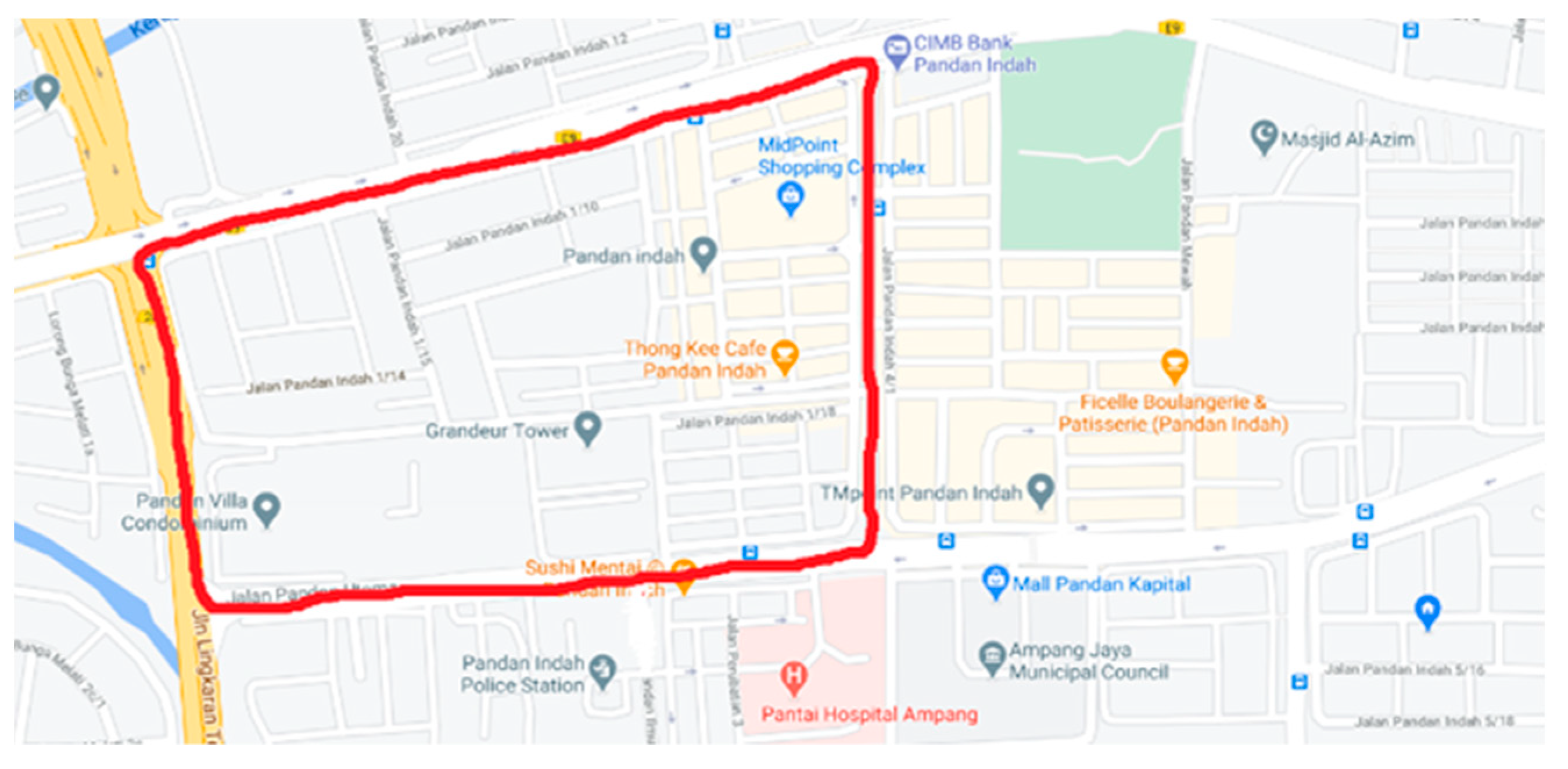
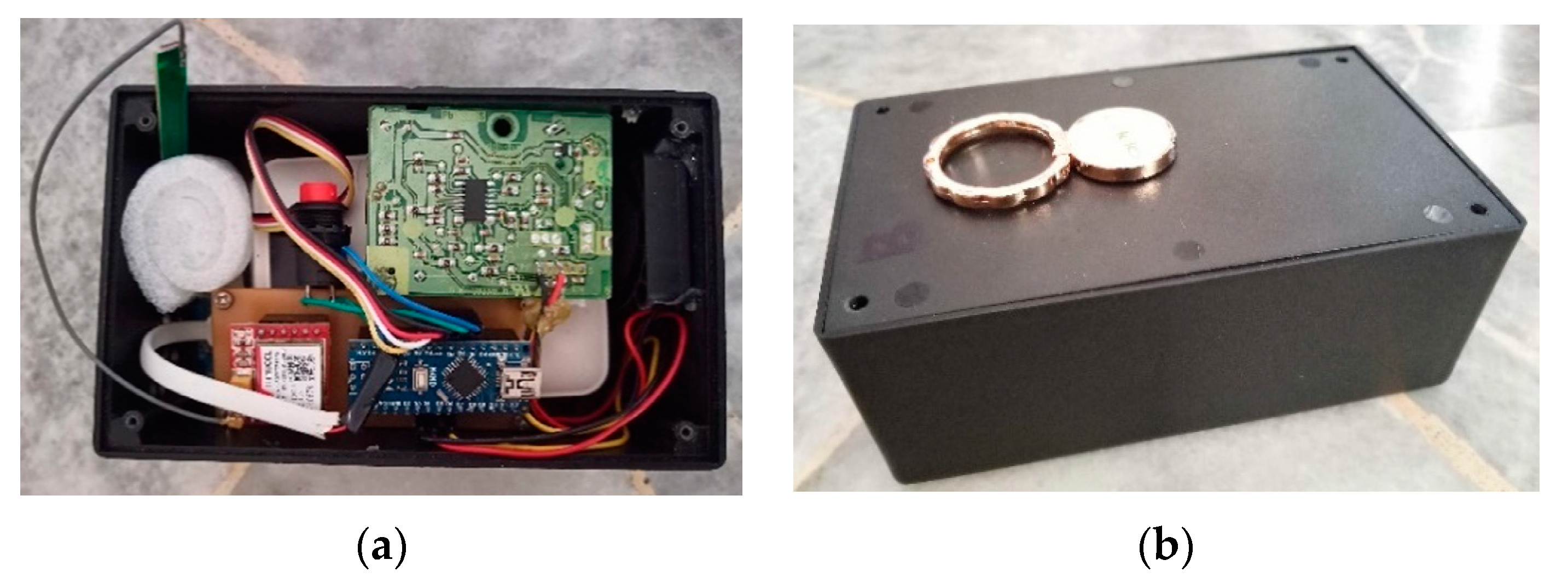



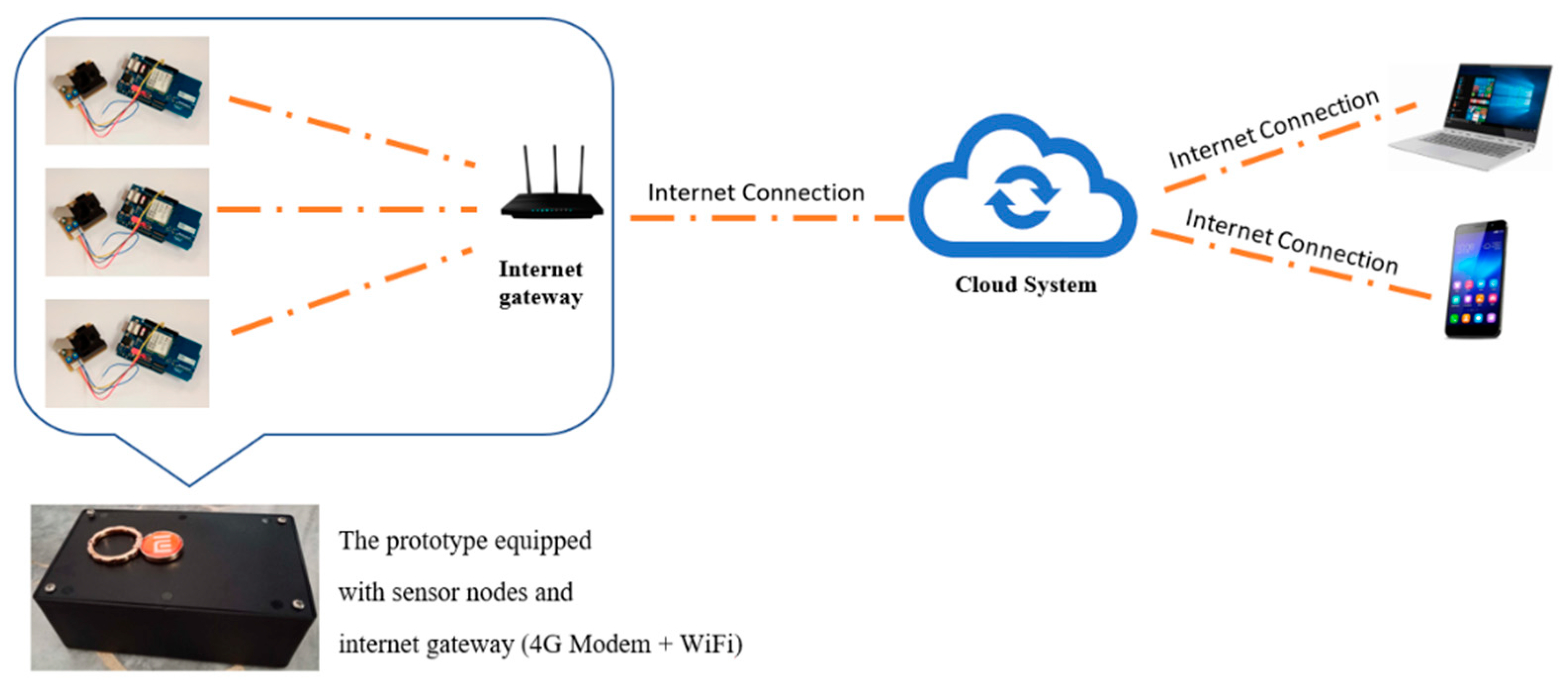
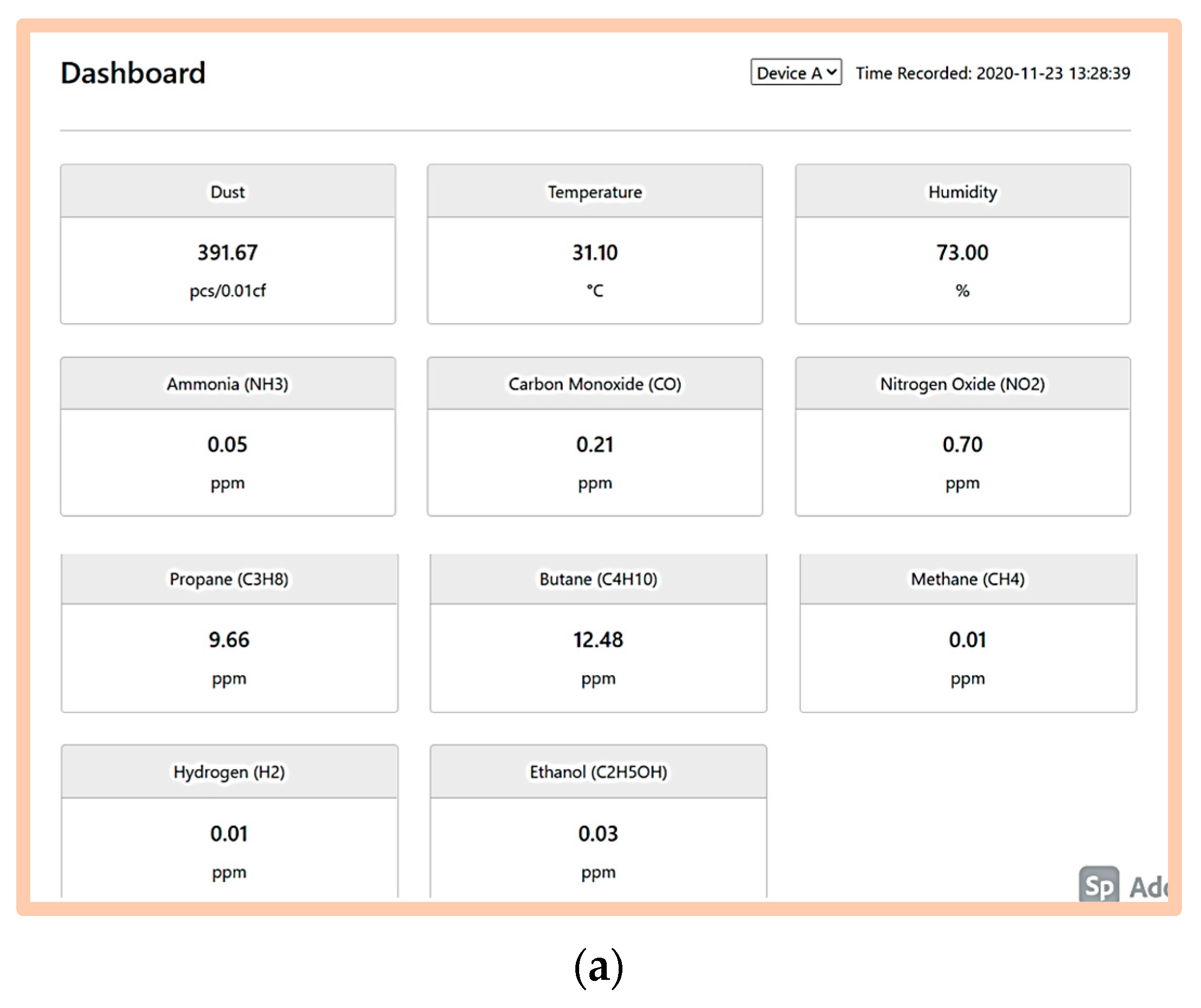
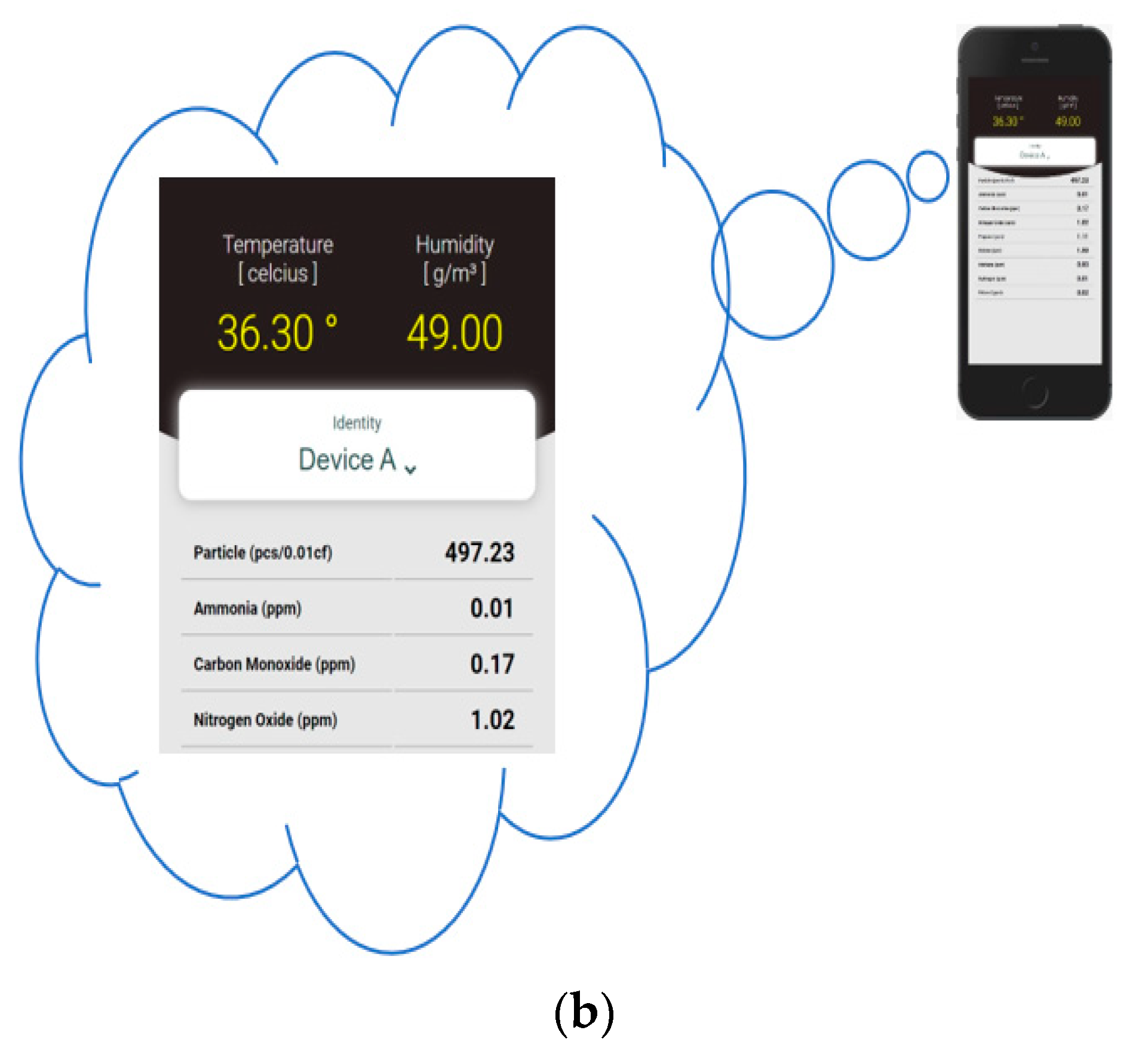
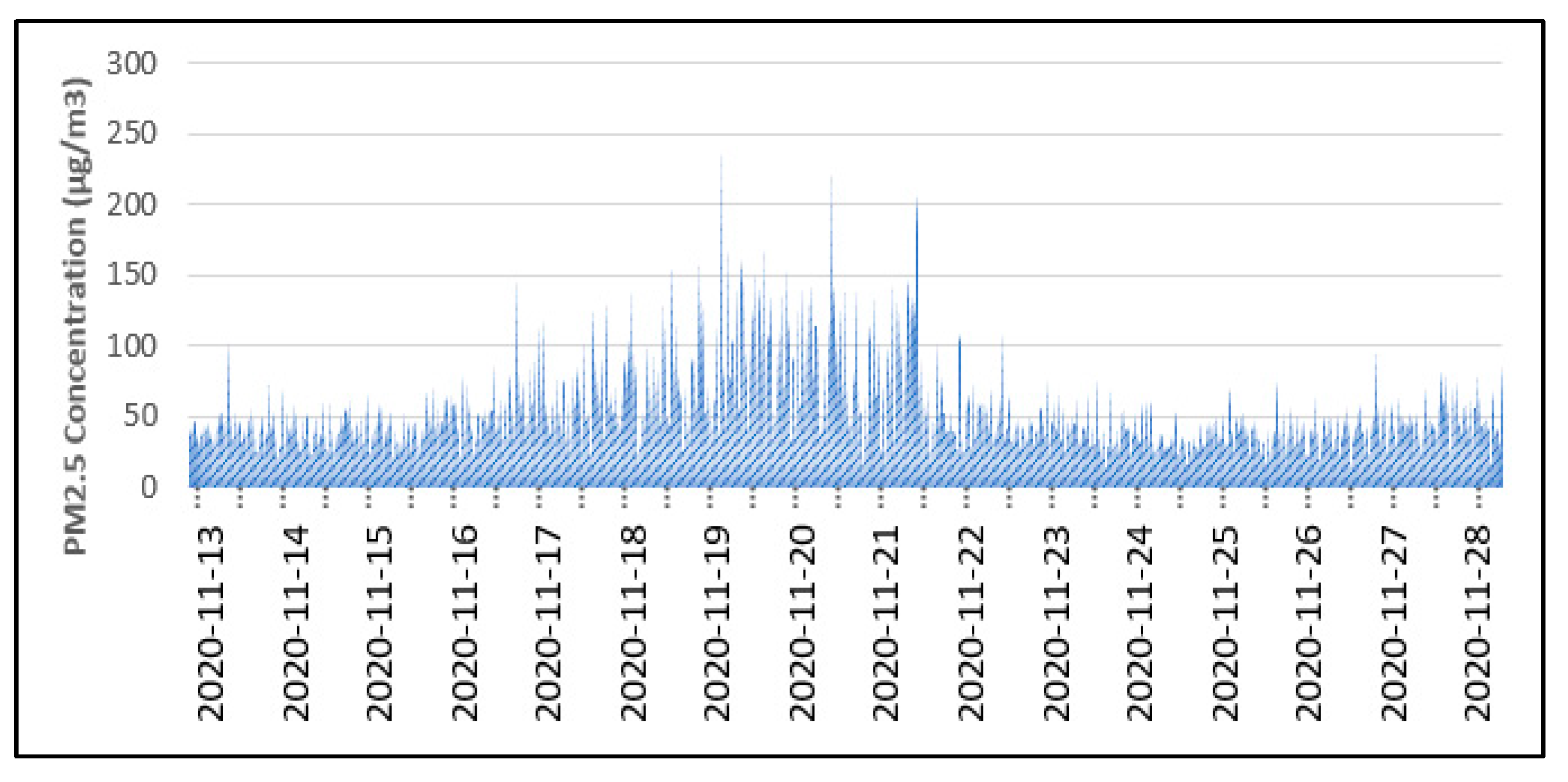
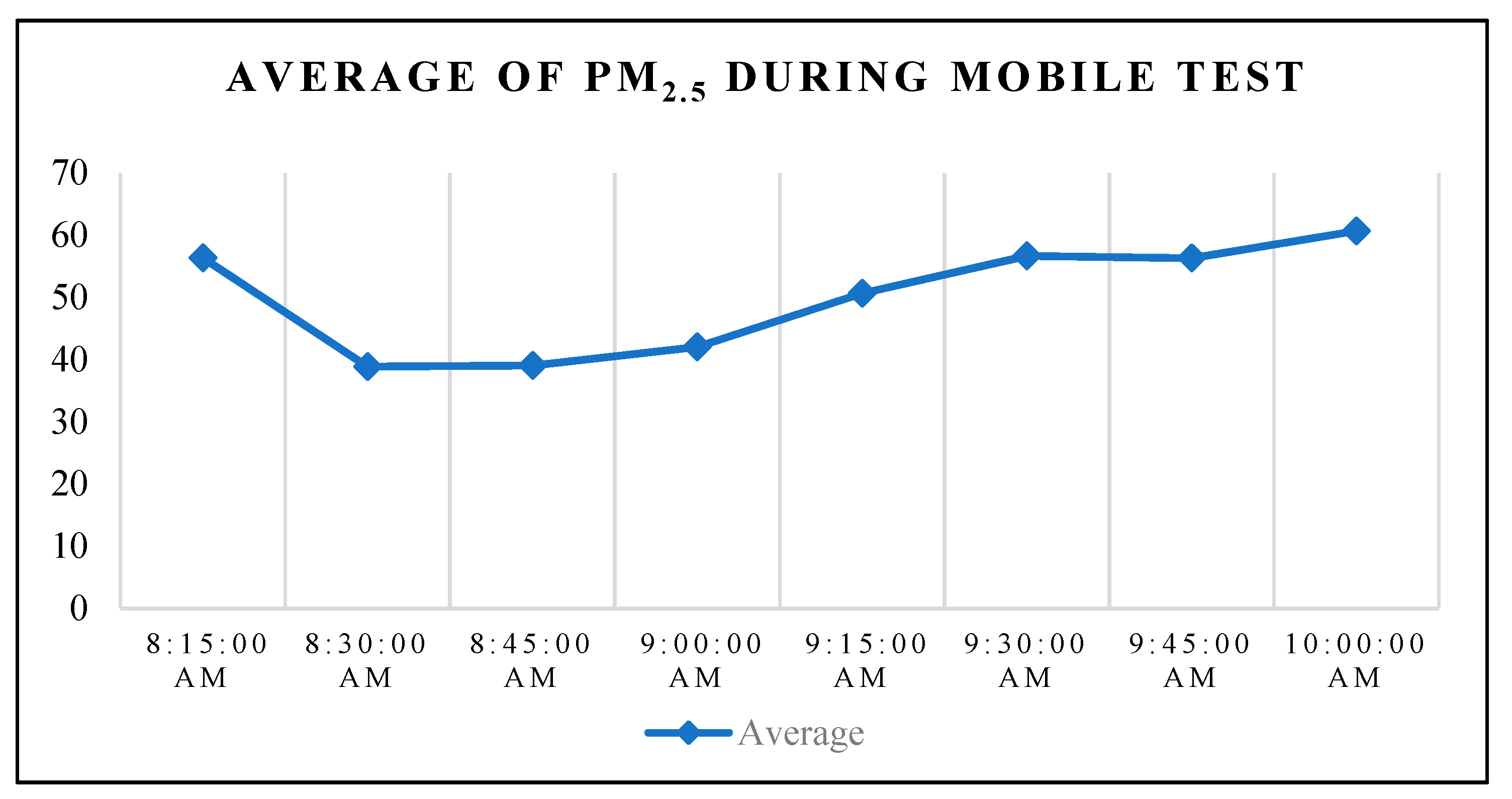

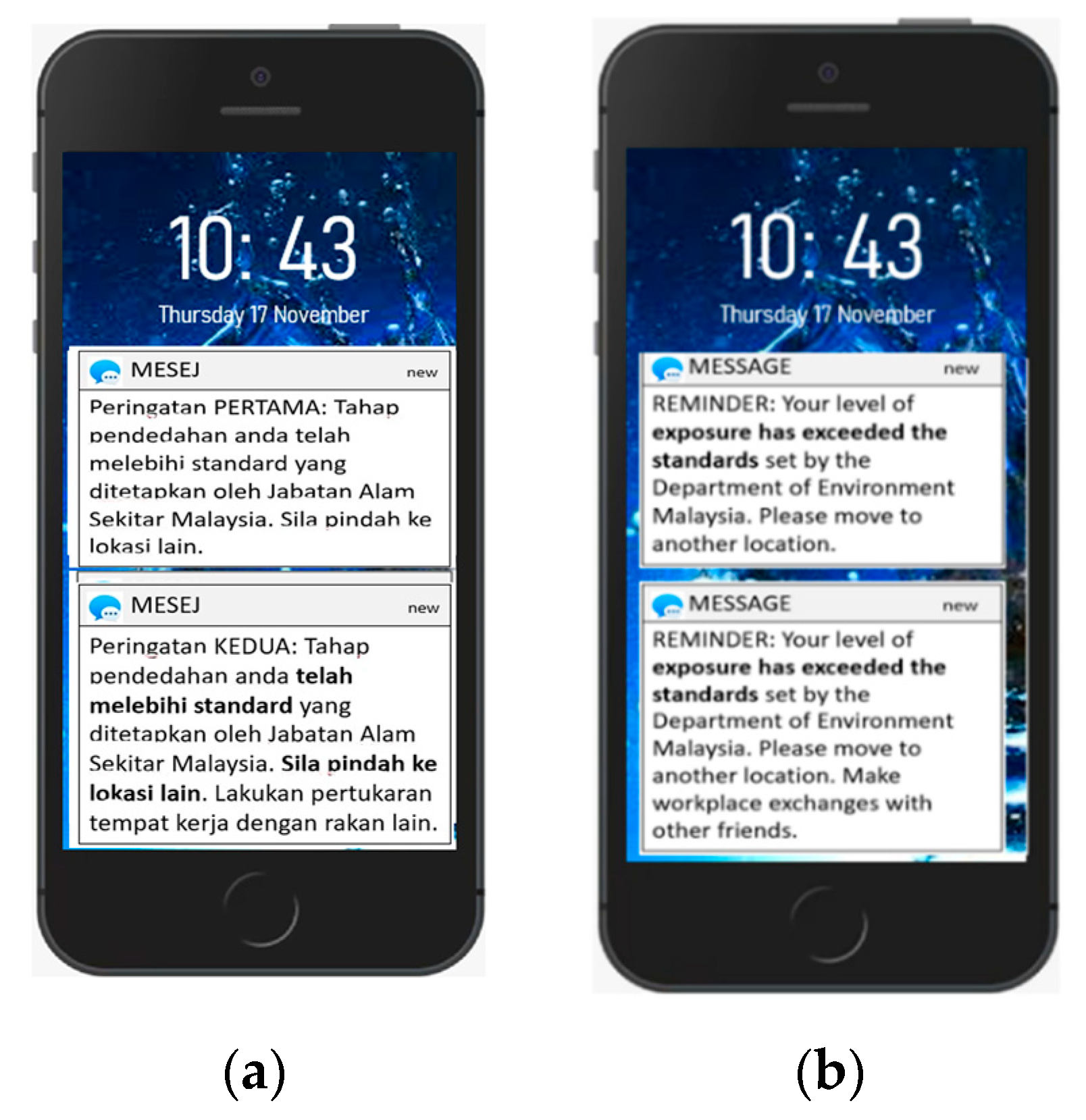
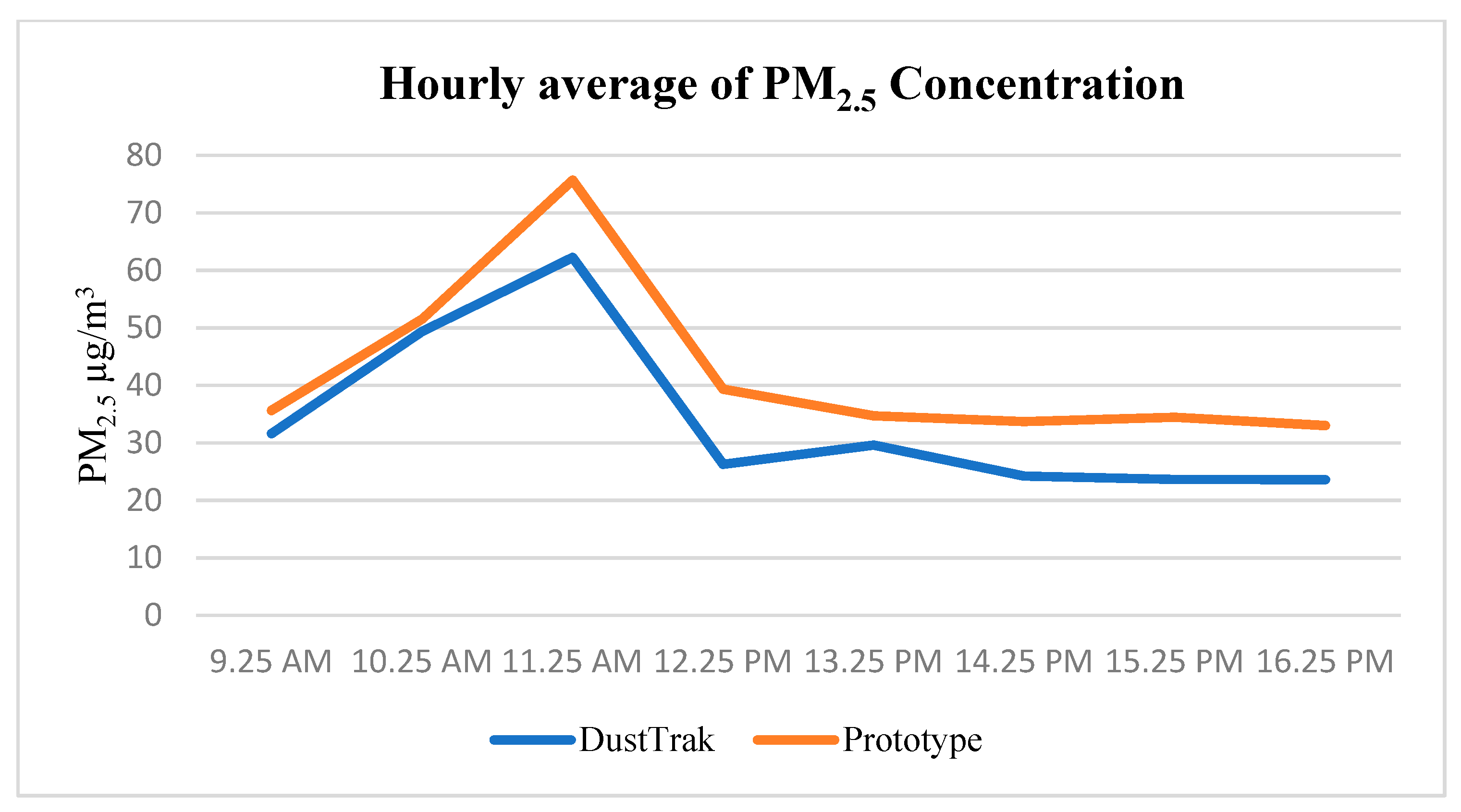
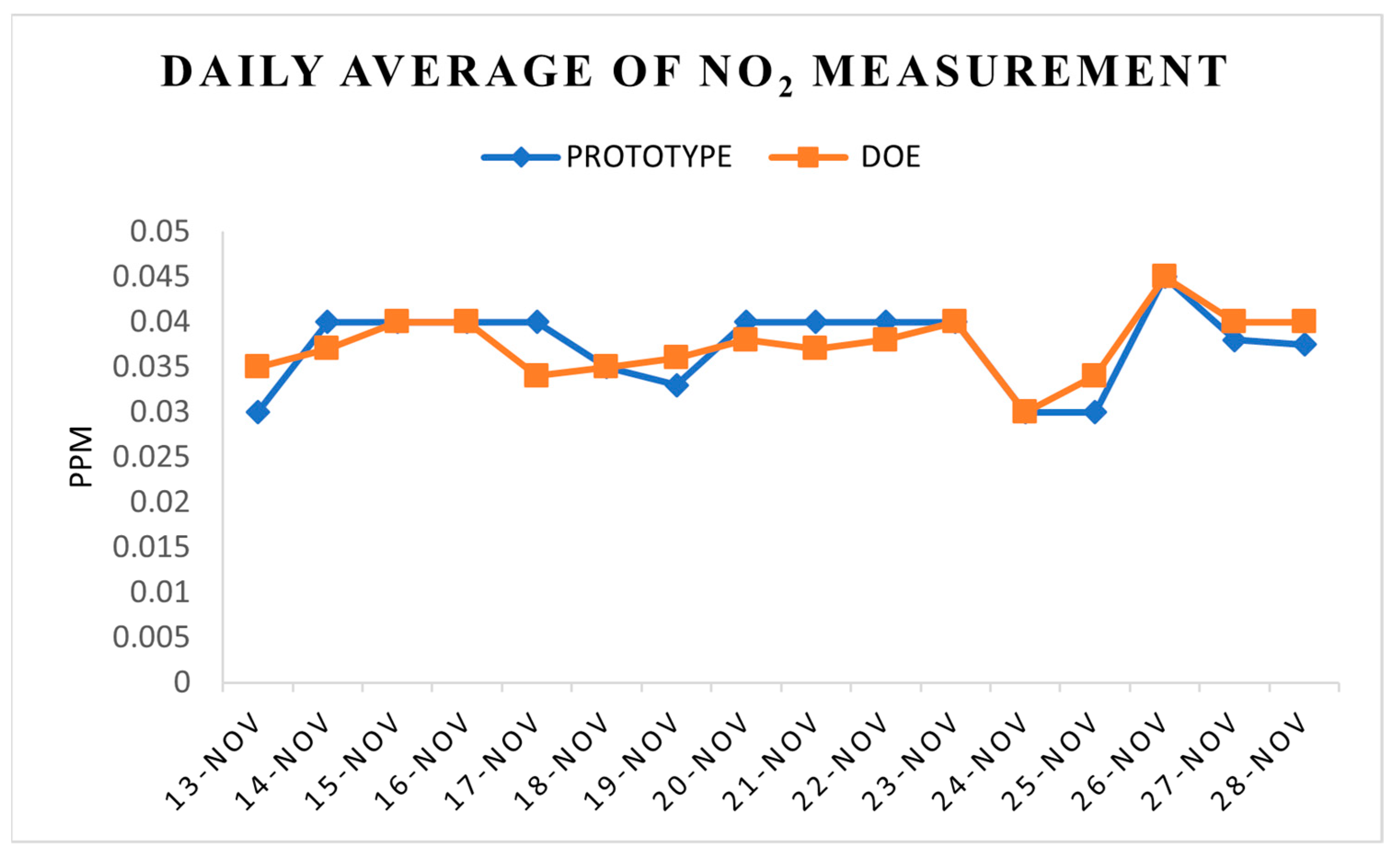
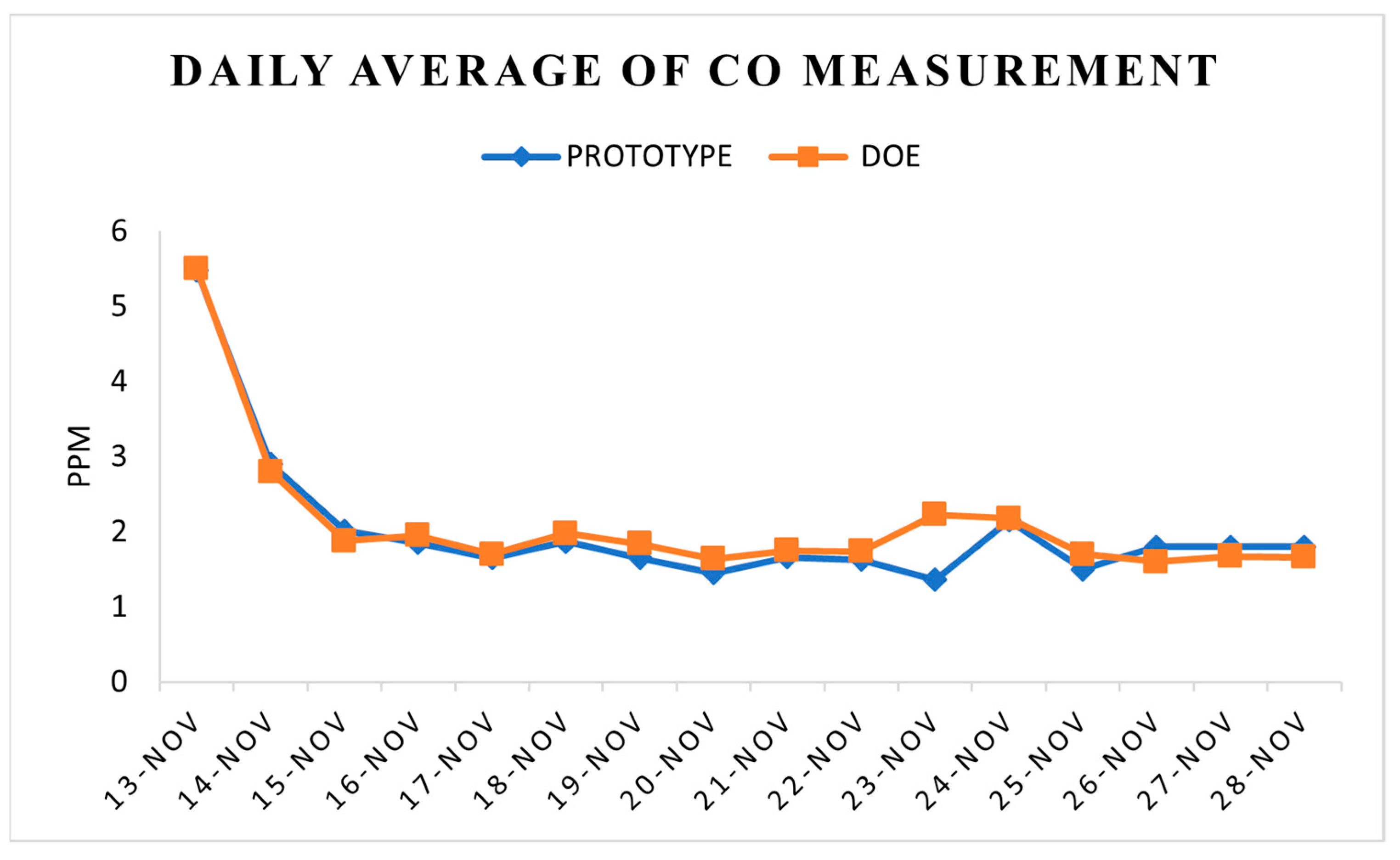
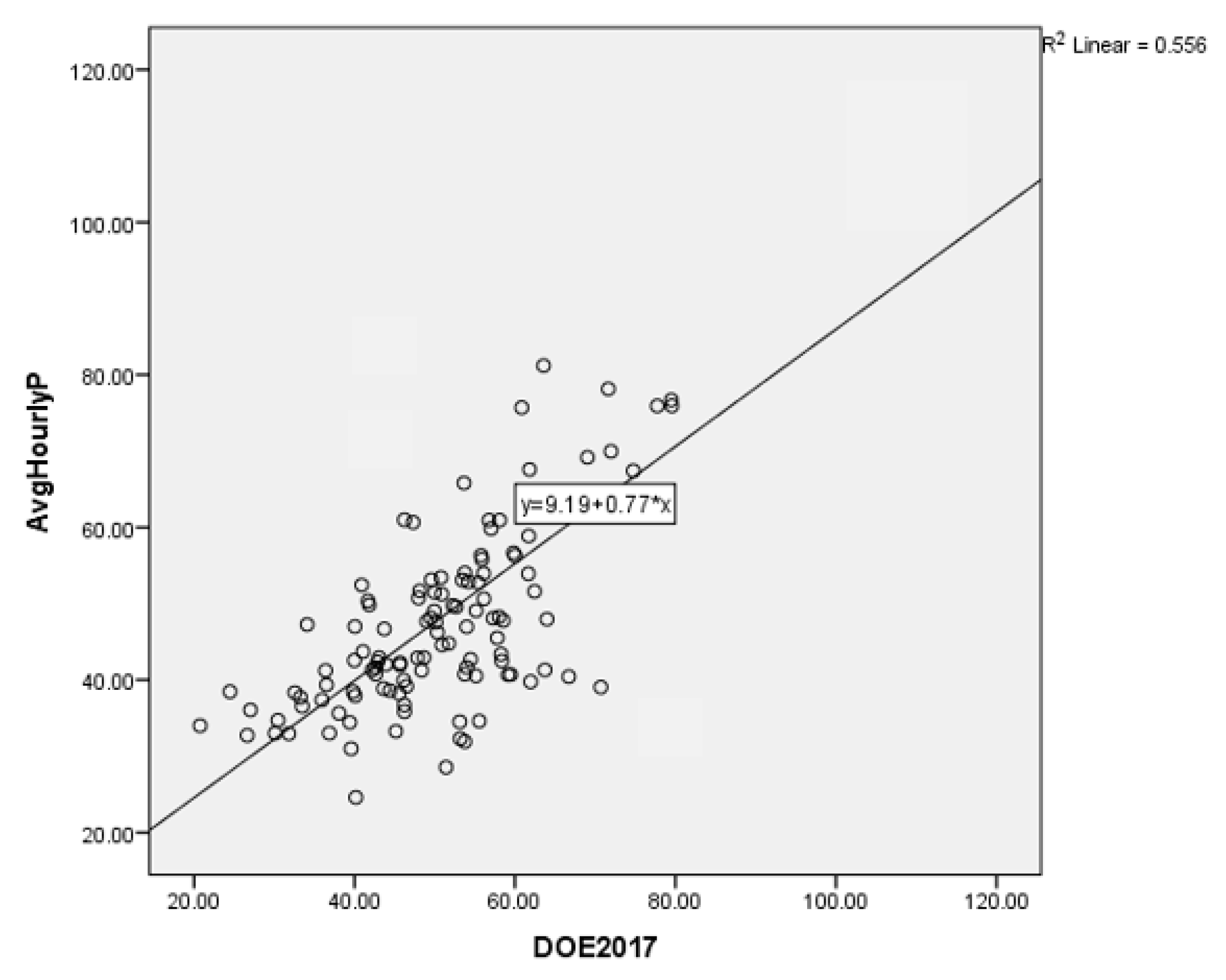
| Parameters | Reference Monitor |
|---|---|
| Particulate Matter with diameter of less than 2.5 micrometers (PM2.5) | TSI DUSTTRAK II Aerosol Monitor 8532 |
| Carbon Monoxide (CO) | Data provided by Malaysia’s Department of Environment (DOE) |
| Nitrogen Dioxides (NO2) |
| Criteria | Requirements | |
|---|---|---|
| 1 | Performance | Using a cellular connectivity and rechargeable power supply; Data to be measured and uploaded at 5 s time interval. |
| 2 | Environment | It can withstand relatively high and low temperatures (0–60°), vibration, and shock. |
| 3 | Life in service | It can withstand up to 2 to 5 years with regular calibration as claimed by the manufacturer, SHINYEI Technology Co., Ltd. (Osaka, Japan). Further long-term experimentation needs to be conducted to support the claim. |
| 4 | Maintenance | Easy regular calibration is required for accuracy of data and efficient performance. |
| 5 | Standard & Specification | Able to measure important parameters (according to the Malaysian Department of Environment and US EPA) of air pollution: Particulate Matter (PM2.5) Carbon Monoxide Nitrogen Dioxide Temperature and humidity Multi gases (Propane, Butane, Ammonia) |
| 6 | Size | Handheld size and mobile |
| 7 | Weight | Lightweight material (<1 kg) |
| 8 | Target Product Cost | Much lower cost compared to the conventional air monitoring station. |
| 9 | Materials | It must be made from a strong, lightweight, water-resistant, and shockproof housing for all the sensors to be embedded inside. |
| 10 | Customer | Traffic policemen (exposed to outdoor air pollution). |
| 11 | Installation | Easily operated with a switch on the casing and is powered using a power bank. Once switched on, the data are uploaded to the website and mobile application. The website serves as a platform to collect and store the measured data at 5 s intervals. The device is wearable and mobile, does not need to be fixed to anything. |
| Items | Functions |
|---|---|
| Power Supply Module Battery | A battery is a device that stores chemical energy and converts it into electrical energy which produces an electrical current that can be used to do work [35]. |
| Voltage regulator | The voltage regulator produces an output voltage of a fixed magnitude that remains constant in relation to changes in its input voltage or load conditions [36]. |
| Charging circuit | Functions switch between the conductive state to enable the current flow and the non-conductive state to prevent the current flow [37]. |
| Dust Sensor (Shinyei PPD42NS Low-Cost Particulate Matter Sensor) | Capable of detecting dust in the environment using an optical sensing method. A photosensor and an infrared light-emitting diode, known as the IR LED, are optically arranged in the dust sensor module. The photosensor (PT) detects the reflected IR LED rays which are bounced off of the dust particles in the air [38]. |
| DHT 11 (Temperature and air humidity) | A digital temperature and humidity sensor is used to measure the surrounding air and emits a digital signal to the data pin (no analog input pins are needed) [39]. |
| CPU ESP32 Wi-Fi Module | It can either host an application or import all WiFi networking functions from another application processor [40]. |
| General Purpose Input Output | Sends signals from sensors to the system [41]. |
| Serial Communication | To transmit or receive one bit of data at a time [24]. |
| Multi-channel Gas Sensor | A sensor for the environment which is capable of detecting multiple gas types. Three gases can be measured simultaneously due to its multi-channel; hence, it is able to monitor more than one gas concentration [42]. |
| 4G Modem + Wi-Fi | Transparent communication between mobile phones and serial devices [24]. |
| Variables | Frequency | r Value | p Value |
|---|---|---|---|
| PM2.5 Prototype/DustTrak | 128 | 0.216 | 0.014 * |
| NO2 Prototype/DOE | 128 | 0.576 | 0.02 * |
| CO Prototype/DOE | 128 | 0.545 | 0.036 * |
| Variables | b (95% CI) | t Statistics | p Value | r2 |
|---|---|---|---|---|
| DustTrak | 0.768 (0.684, 0.889) | 12.552 * | <0.001 | 0.556 |
Disclaimer/Publisher’s Note: The statements, opinions and data contained in all publications are solely those of the individual author(s) and contributor(s) and not of MDPI and/or the editor(s). MDPI and/or the editor(s) disclaim responsibility for any injury to people or property resulting from any ideas, methods, instructions or products referred to in the content. |
© 2023 by the authors. Licensee MDPI, Basel, Switzerland. This article is an open access article distributed under the terms and conditions of the Creative Commons Attribution (CC BY) license (https://creativecommons.org/licenses/by/4.0/).
Share and Cite
Mohamad Jamil, P.A.S.; Mohammad Yusof, N.A.D.; Karuppiah, K.; Rasdi, I.; How, V.; Mohd Tamrin, S.B.; Samsudin, M.H.; Sambasivam, S.; Almutairi, N.S. Concept Development and Field Testing of Wireless Outdoor Indicator System for Use in Monitoring Exposures at Work among Malaysian Traffic Police. Toxics 2023, 11, 385. https://doi.org/10.3390/toxics11040385
Mohamad Jamil PAS, Mohammad Yusof NAD, Karuppiah K, Rasdi I, How V, Mohd Tamrin SB, Samsudin MH, Sambasivam S, Almutairi NS. Concept Development and Field Testing of Wireless Outdoor Indicator System for Use in Monitoring Exposures at Work among Malaysian Traffic Police. Toxics. 2023; 11(4):385. https://doi.org/10.3390/toxics11040385
Chicago/Turabian StyleMohamad Jamil, Putri Anis Syahira, Nur Athirah Diyana Mohammad Yusof, Karmegam Karuppiah, Irniza Rasdi, Vivien How, Shamsul Bahri Mohd Tamrin, Muhammad Hasnolhadi Samsudin, Sivasankar Sambasivam, and Nayef Shabbab Almutairi. 2023. "Concept Development and Field Testing of Wireless Outdoor Indicator System for Use in Monitoring Exposures at Work among Malaysian Traffic Police" Toxics 11, no. 4: 385. https://doi.org/10.3390/toxics11040385
APA StyleMohamad Jamil, P. A. S., Mohammad Yusof, N. A. D., Karuppiah, K., Rasdi, I., How, V., Mohd Tamrin, S. B., Samsudin, M. H., Sambasivam, S., & Almutairi, N. S. (2023). Concept Development and Field Testing of Wireless Outdoor Indicator System for Use in Monitoring Exposures at Work among Malaysian Traffic Police. Toxics, 11(4), 385. https://doi.org/10.3390/toxics11040385






